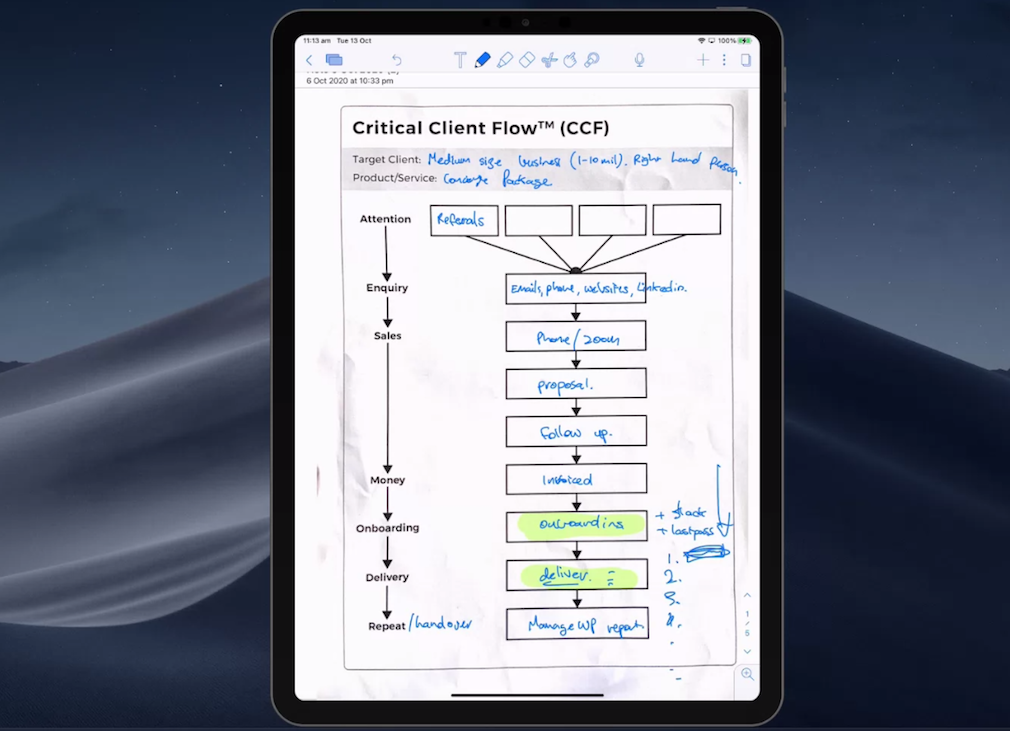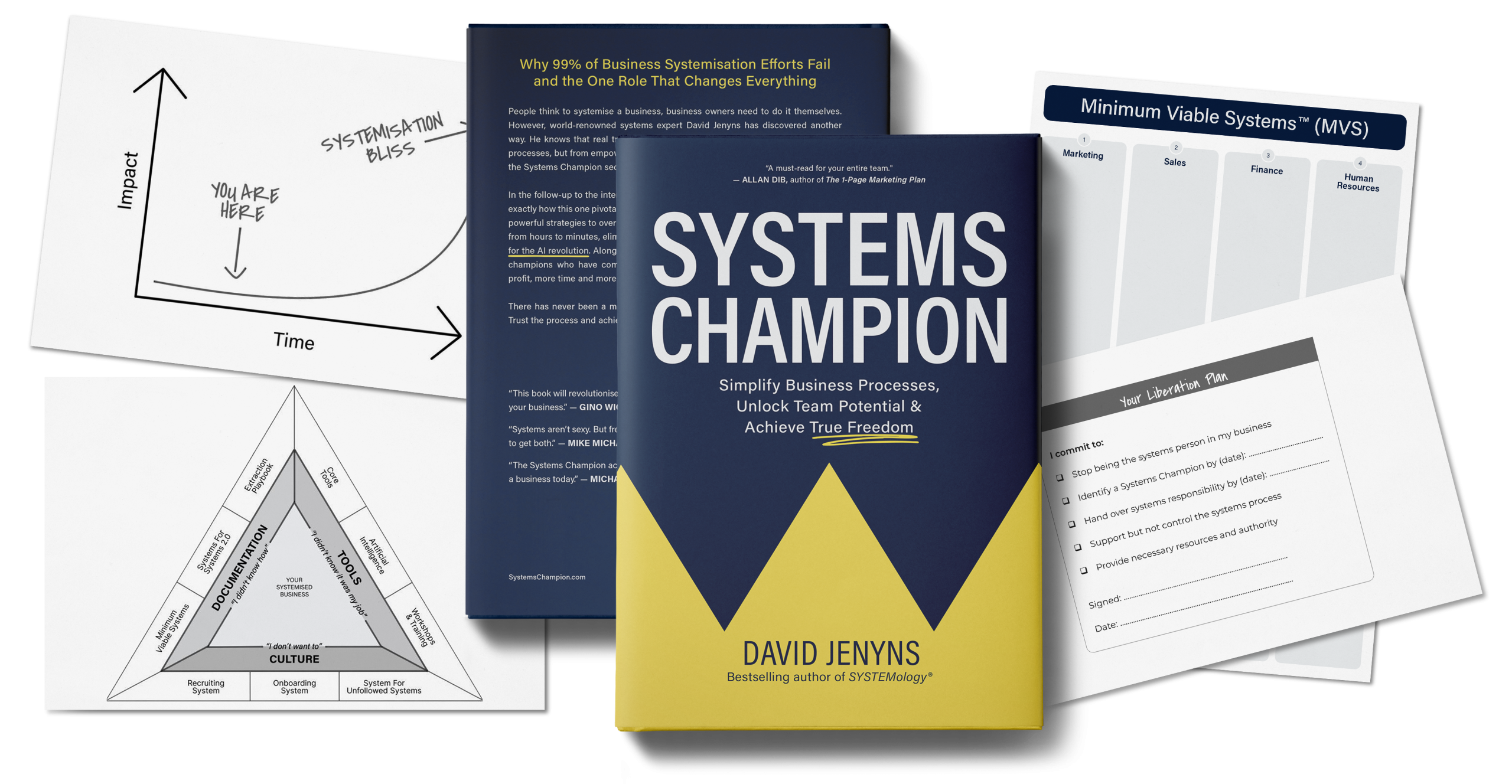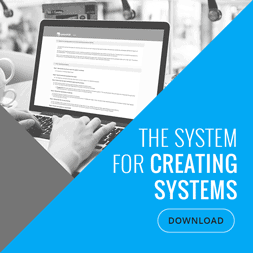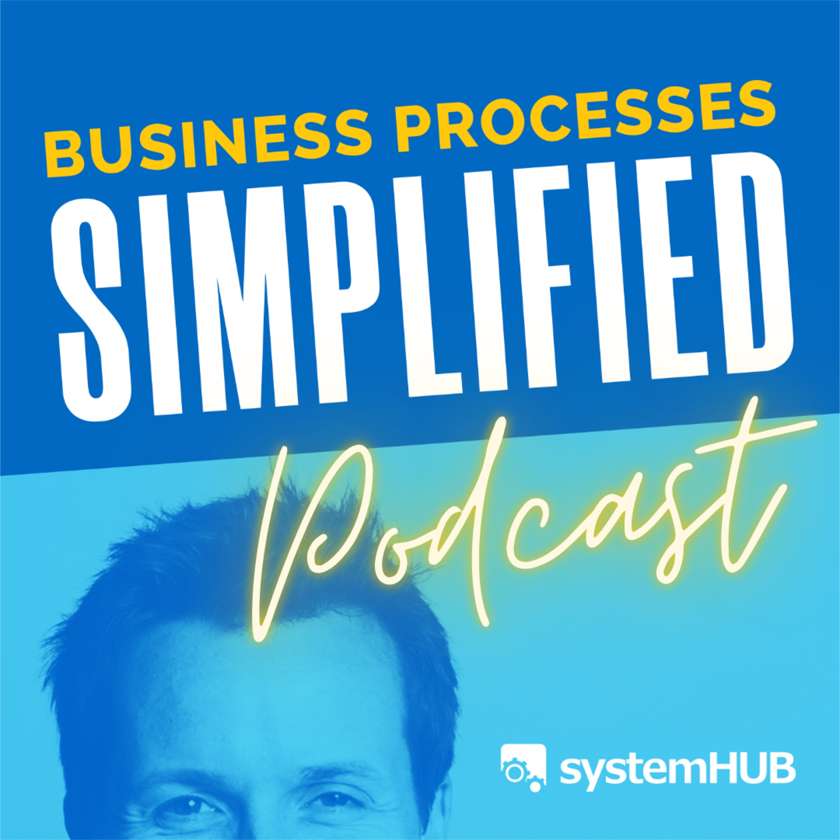Business owners often miss out on profits, not due to weak marketing or pricing but because they fail to tap into the hidden multipliers that efficient systems provide.
David Jenyns, SYSTEMology founder and systems expert, spoke with Shannon Smit, founder of Smart Business Solutions in Melbourne. Her accounting practice serves thousands of clients with over 20 team members. But seven years ago, she was drowning in manual processes, watching her best people do low-value work while profit margins stayed flat.

Today, her team has automated processes that save nearly 1,000 hours annually. One administrative role was completely automated, freeing team members for high-value client work. The transformation didn’t happen through expensive consultants or complex software. It happened through systematic documentation and the SYSTEMology methodology.
Here’s what most business owners miss: effective business systems don’t just cut costs. They create hidden profit multipliers that compound over time, often delivering returns that dwarf the initial investment.

Traditional process improvement focuses on fixing what’s broken. SYSTEMology takes a different approach. Instead of buying expensive systems or hiring consultants, it extracts the proven processes already working in your business.
Your business is already functioning. The knowledge exists in your team’s heads, your best practices are being used (inconsistently), and your most productive approaches are already proven.
SYSTEMology simply makes the invisible visible through systematic documentation.
This approach, combined with a dedicated Systems Champion and the systemHUB platform, creates a foundation for sustainable profit growth that builds on your existing strengths.
10 Indirect Ways Systems Multiply Your Profits
1. Owner Freedom Creates Strategic Growth Opportunities
The most expensive employee in your business is you, working on tasks someone else could handle.
When you’re constantly interrupting strategic work to answer questions, approve routine decisions, or fix operational problems, you’re essentially paying executive-level wages for operational tasks. Effective business systems eliminate this expensive inefficiency.
Alison Rogers, founder of Vocal Manoeuvres Academy, describes her pre-systems experience: “I had this constant state of heightened anxiety, always on edge, always working, burying my head in the sand when tasks felt too enormous.”
Sound familiar?
“The most expensive employee in your business is you, working on tasks someone else could handle.”
Systems create what we call “owner liberation.” When your team has documented processes for routine decisions, clear guidelines for common situations, and structured approaches to recurring tasks, they stop needing you for operational questions.
This freedom isn’t about working less (though that’s a nice side effect). It’s about working on activities that only you can do: strategic planning, business development, key relationship building, and innovation.
If you’re currently worth $200 per hour strategically but spending 20 hours weekly on operational tasks that could be systematized, you’re losing $4,000 weekly in potential value creation. That’s over $200,000 annually in missed opportunities.
2. Customer Loyalty Through Consistency Drives Repeat Revenue
Customers don’t just buy products or services. They buy experiences.
When your delivery is inconsistent, customers feel it. One day they get exceptional service, the next day it’s mediocre. One project runs smoothly; another hits every possible snag. This inconsistency creates anxiety in your customers, and anxious customers start looking for alternatives.

Systematic delivery processes create the opposite effect. Customers know what to expect, when to expect it, and how you’ll handle any issues that arise. This predictability builds trust, and trust builds loyalty.
The numbers are compelling: acquiring a new customer costs 5-25 times more than retaining an existing one. Loyal customers spend 67% more than new customers. They also become your best marketing asset through referrals and testimonials.
Consider a service business with 100 customers generating $200,000 annually. If systematic processes increase customer retention from 80% to 88%, and loyal customers spend 20% more over their lifetime, the profit impact is substantial. You’re not just saving on acquisition costs; you’re increasing lifetime value across your entire customer base.
Smart systematic businesses also build referral generation into their processes. When customers consistently have great experiences, asking for referrals becomes natural rather than awkward.
3. Cash Flow Velocity Through Efficient Operations
Cash flow problems kill more businesses than competition ever will.
Efficient systems accelerate how quickly money moves through your business. Streamlined project delivery means faster invoicing. Systematic follow-up processes reduce payment delays. Automated administrative tasks eliminate bottlenecks that slow down revenue recognition.
Shannon Smit’s automation results demonstrate this perfectly. By documenting and then automating routine processes, her team eliminated hundreds of hours of manual work annually. But the cash flow benefits extended beyond labor savings.
Faster project completion means faster billing. Systematic client communication reduces payment delays. Automated invoicing eliminates the “forgot to bill” delays that plague many service businesses. These improvements compound to significantly accelerate cash flow velocity.
“Cash flow problems kill more businesses than competition ever will.”
Here’s a practical example: if systematic processes reduce your average project delivery time from 14 days to 12.6 days (a modest 10% improvement), you can complete more projects per month with the same resources. More completions mean more invoicing opportunities and faster cash flow cycles.
The working capital benefits are huge. Faster cash cycles mean less money tied up in work-in-progress, reduced borrowing needs, and more cash available for growth investments.
4. Employee Retention Cuts Hidden Costs
Employee turnover is expensive, but most business owners dramatically underestimate the real costs.
Beyond obvious expenses like recruitment and training, turnover affects customer relationships, team morale, institutional knowledge retention, and competitive positioning. The Society for Human Resource Management estimates that replacing an employee costs 50-200% of their annual salary.
Systematic work environments reduce turnover in several ways. Clear processes eliminate the frustration of constantly figuring things out. Documented procedures help new employees succeed faster, reducing early-stage departures. Organized operations create professional environments that people want to be part of.
But here’s the hidden benefit: systematic businesses attract better employees.
Quality candidates prefer structured environments where they can focus on meaningful work rather than constantly improvising. They want clear expectations, professional development opportunities, and the satisfaction of being part of something well-organized.
“Systematic businesses attract better employees.”
Consider a business with 20 employees where systems reduce annual turnover from 25% to 15%. That’s two fewer replacements annually. If the average replacement cost is $15,000 per employee, systematic operations save $30,000 yearly just in turnover costs. But the productivity benefits of retaining experienced, engaged employees multiply these savings significantly.
5. Results-Driven Culture Boosts Productivity
What gets measured gets improved, but systematic businesses take this principle further.
When processes are documented and results are tracked, accountability becomes natural rather than forced. Team members can see how their work connects to business outcomes. They understand what success looks like and have clear pathways to achieve it.
This transparency creates what we call “positive peer pressure.” When everyone can see performance metrics and process adherence, team members naturally push each other toward higher standards. Nobody wants to be the person dragging down team results.
Systematic businesses also make improvement easier. When processes are documented, identifying bottlenecks becomes straightforward. When results are measured, testing improvements becomes scientific rather than guesswork.
The productivity gains compound over time. A 5% monthly improvement in team productivity doesn’t just add 5% to your results. It creates exponential growth as improvements build on improvements.
Alison Rogers experienced this transformation at Vocal Manoeuvres Academy. As systems eliminated the chaos and anxiety, her team became more engaged and productive. The business transformed from reactive firefighting to proactive growth planning.

6. Organized Operations Attract Quality Talent
Great employees have choices about where to work.
They choose organized, professional environments over chaotic ones. They want to join businesses that invest in proper systems, clear processes, and structured growth rather than companies that rely on heroic individual efforts to survive.
This preference creates a competitive advantage for systematic businesses. You can attract better talent, often at competitive wages, because quality candidates value professional environments over pure compensation.
Better talent performs better, stays longer, and contributes more to business growth. They also require less management oversight because they thrive in structured environments rather than needing constant direction.
The recruitment benefits extend beyond individual hires. Quality employees refer other quality candidates. They speak positively about your business in professional circles. They become ambassadors for your culture and approach.
“Quality candidates value professional environments over pure compensation.”
This talent attraction advantage compounds over time. Each great hire makes your business more attractive to the next great candidate, creating an upward spiral of talent quality that directly impacts productivity and profitability.
7. Competitive Advantage Through Superior Delivery
In competitive markets, systematic businesses consistently outperform their chaotic competitors.
They deliver better results because documented processes capture best practices and prevent errors. They deliver faster because streamlined operations eliminate unnecessary steps and delays. They deliver at lower costs because efficient systems reduce waste and rework.
This combination of better, faster, and more cost-effective service creates what Michael Porter calls sustainable competitive advantage. Customers choose you not just for price, but for the superior experience your systematic operations provide.
The profit impact extends beyond direct sales. Superior delivery capabilities allow premium pricing strategies. When customers consistently receive exceptional results, they become less price-sensitive and more loyalty-focused.
Systematic businesses also win larger projects and better clients. Enterprise customers particularly value vendors who can demonstrate systematic approaches to project management, quality control, and risk management. These larger, more profitable engagements often have lower sales costs and longer payment terms.
8. Market Differentiation Increases Customer Acquisition

Seth Godin’s “Purple Cow” concept fits systematic businesses perfectly.
In a crowded marketplace, only the remarkable get noticed. A Purple Cow is something so distinctive and bold that people can’t help but talk about it, the kind of innovation that turns heads without relying on traditional marketing.
That’s exactly what systematic businesses do. In industries full of unpredictable providers, they stand out by showing their process, proving their quality, and consistently delivering results their customers can vouch for.
This differentiation dramatically improves marketing effectiveness. Instead of competing purely on price or promising vague “quality” benefits, systematic businesses can demonstrate their systematic advantage through case studies, process documentation, and measurable results.
The customer acquisition benefits multiply through referral generation. Satisfied customers become active promoters when they can clearly articulate why their experience was superior. They don’t just say “they’re good,” they explain the systematic approach that delivered their exceptional results.
Marketing costs also decrease over time as reputation and referrals reduce dependence on paid acquisition channels. Word-of-mouth marketing has the highest conversion rates and lowest acquisition costs, but it requires consistently exceptional delivery that only systematic operations can provide.
9. Business Valuation Multipliers for Exit Planning
Systematic businesses sell for significantly higher multiples than owner-dependent operations.
Buyers pay premiums for businesses that can operate without the current owner’s daily involvement. They value documented processes, systematic operations, and transferable business models over businesses that depend on individual expertise or relationships.
The valuation difference is substantial. Owner-dependent businesses might sell for 1-2x annual profits, while systematic businesses often command 3-5x multiples or higher. For a business generating $500,000 annual profit, this difference represents $1-2 million in additional exit value.
But the benefits extend beyond sale price. Systematic businesses are easier to sell because they present lower risk to buyers. Due diligence processes are smoother when operations are documented and results are measurable. Financing is more readily available when lenders can see systematic revenue generation and risk management.
“Systematic businesses sell for significantly higher multiples than owner-dependent operations.”
Even if you never plan to sell, this valuation premium represents real wealth creation. It provides options for partnerships, investment opportunities, or legacy planning that owner-dependent businesses simply cannot access.
10. Scalability Unlocks Exponential Growth
The ultimate profit multiplier: systematic operations enable replication and scaling that creates exponential growth opportunities.
When your business success depends on documented processes rather than individual heroics, expansion becomes systematically possible. You can open new locations, franchise your model, or license your systems because success isn’t tied to your personal involvement.
This scalability creates multiple profit centers from a single systematic foundation. Each new location or franchise generates revenue streams that leverage your existing systems investment. The marginal cost of replication is low while the revenue potential is substantial.
Even without physical expansion, systematic operations enable service scaling through team growth, automation, and process optimization. You can serve more customers with proportionally smaller increases in costs because systems create efficiency multipliers.
The long-term wealth creation potential is enormous. Businesses that master systematic operations can grow beyond the founder’s personal capacity limitations, creating enterprise value that extends far beyond traditional service business models.
The Compound Effect: Real ROI Calculations
Case Study Deep Dive: Smart Business Solutions
Shannon Smit’s seven-year transformation with systemHUB demonstrates the compound benefits of systematic operations.
Starting as a solo accountant, Shannon built Smart Business Solutions into a firm serving thousands of clients with over 20 team members. The key was systematic documentation and strategic automation.

Her team spent six to seven years building such a comprehensive library of systems in systemHUB, that “Is it in systemHUB?” became their catchphrase. This documentation foundation enabled strategic automation implementation that saved 998 hours annually on just one process.
But the real transformation was cultural.
Team members who initially feared automation began actively suggesting processes for automation. The systematic approach eliminated the anxiety and chaos that plague many accounting practices, creating a professional environment where people wanted to work and grow.
The financial impact extended beyond direct labor savings. Systematic operations enabled the firm to focus on high-value client relationships while automating routine tasks. This combination improved client satisfaction, increased retention rates, and created capacity for growth without proportional increases in overhead.
Your Profit Potential Calculator
Here’s the compound effect with specific numbers.
Imagine a service business handling 50 client projects monthly. Each project generates $2,000 revenue with a 25% profit margin. Your team spends 10 hours per project with 14-day average delivery times.
“With just 10% improvements in four areas, you’ve created a 34% increase in monthly profit.”
Current situation:
- Monthly revenue: 50 projects × $2,000 = $100,000
- Monthly profit: $100,000 × 25% = $25,000
- Team capacity: 50 projects × 10 hours = 500 hours monthly
Now implement systematic operations with modest 10% improvements across four areas:
- Documented client onboarding reduces project time from 10 to 9 hours
- Standardized delivery processes improve timelines from 14 to 12.6 days
- Consistent quality standards justify price increases from $2,000 to $2,200
- Streamlined operations increase profit margins from 25% to 27.5%
After systematization:
- Monthly revenue: 50 projects × $2,200 = $110,000
- Monthly profit: $110,000 × 27.5% = $30,250
- Team efficiency: 50 projects × 9 hours = 450 hours monthly
- New capacity: 500 hours ÷ 9 hours = 55.5 projects possible
That’s a 21% increase in monthly profit ($5,250) plus capacity for 5.5 additional projects.
If you capture that additional capacity:
- Additional revenue: 5.5 projects × $2,200 = $12,100
- Additional profit: $12,100 × 27.5% = $3,327.50
Final results:
- Total monthly revenue: $122,100 (22.1% increase)
- Total monthly profit: $33,577.50 (34.3% increase)
- Annual profit increase: $102,930
With just 10% improvements in four areas, you’ve created a 34% increase in monthly profit. And we’ve only systematized a handful of processes in the business.
The Critical Client Flow Impact

The SYSTEMology methodology focuses on seven proven systems within what we call the Critical Client Flow:
- Lead generation system
- Inquiry handling system
- Sales conversion system
- Invoicing and payment system
- Client onboarding system
- Delivery system
- Repeat business or referral system
Each system creates multiple profit improvement opportunities. Lead generation systems reduce acquisition costs. Inquiry systems improve conversion rates. Sales systems increase closing rates and average transaction values. The compound effect of systematic improvements across all eight areas creates exponential profit growth.
The beauty of this approach is that it builds on your existing successes. You’re not buying expensive software or hiring consultants to redesign everything. You’re systematically documenting and optimizing what already works in your business.
Getting Started: Your Systems Champion Strategy
The systemHUB Advantage
systemHUB provides the platform and methodology for systematic business transformation. Unlike generic process management tools, systemHUB is specifically designed for the SYSTEMology approach of extracting, documenting, and optimizing existing business processes.

The platform combines systems management, project tracking, and team collaboration features specifically designed for businesses implementing systematic operations. Real clients like Shannon Smit have used systemHUB to transform their operations over multiple years, creating the foundation for automation and growth.
The SYSTEMology methodology provides the framework for identifying priority systems, extracting knowledge from your team, and implementing systematic operations that generate measurable results.
Implementation Roadmap
Success starts with designating a Systems Champion within your organization. This person becomes responsible for driving the systematic documentation and implementation process.
Your Systems Champion should have strong organizational skills, excellent communication abilities, and the authority to work across departments. They don’t need to be technical experts, but they need to be persistent and detail-oriented.

The implementation process follows the Critical Client Flow framework:
- Map your current client journey from lead to delivery
- Identify the knowledgeable workers in each area
- Extract and document existing processes
- Test and refine documented systems
- Train team members on systematic approaches
- Measure results and optimize continuously
Start with your biggest pain points or highest-impact opportunities. If you have more leads than you can handle, don’t start with lead generation. Focus on the systems that will have the most immediate impact on your business results.
“Success starts with designating a Systems Champion within your organization.”
Common Implementation Challenges and Solutions

The biggest challenge is usually team resistance to change. People fear that systems will make their jobs more rigid or eliminate their value to the organization.
Address this by focusing on how systems benefit team members personally. Systems eliminate frustration, reduce errors, and create opportunities for professional growth. When people understand that systems free them to focus on meaningful work rather than repetitive tasks, resistance typically transforms into enthusiasm.
Time allocation is another common concern. Business owners worry that documentation will take too much time away from revenue-generating activities. The solution is starting small and building momentum through quick wins.
Begin with processes that are already causing problems or consuming excessive time. Document one system thoroughly rather than trying to tackle everything simultaneously. Early successes create momentum and demonstrate value, making larger investments easier to justify.
ROI timeline expectations need to be realistic. Some benefits appear immediately (reduced errors, clearer communication), while others compound over time (customer loyalty, competitive advantage). Plan for 3-6 months before seeing substantial financial impacts, but expect ongoing improvements as systems mature.
Frequently Asked Questions About Business Systems
Your Next Steps: From Chaos to Clockwork
The hidden profit opportunities in your business are real. While your competitors struggle with chaos, inconsistency, and owner-dependency, systematic operations can position you for sustainable growth and exponential profit increases.
“Your next step is simple: start documenting one system this week.”
The case studies aren’t theoretical. Shannon Smit’s accounting practice, Alison Rogers’ vocal academy, and hundreds of other businesses have transformed their operations through systematic approaches. The financial benefits are measurable, the implementation process is proven, and the tools are available.
Your next step is simple: start documenting one system this week.
Choose a process that’s currently causing problems or consuming too much time. Extract the knowledge from whoever does it best. Document the steps clearly. Test the documented process with someone else. Refine based on results.
That’s the beginning of your transformation from chaotic operations to systematic profit growth.

Ready to see what systematic operations can do for your business? Start your free systemHUB trial today and discover the profit opportunities hiding in your current processes. Join the thousands of business owners who have already transformed their operations from chaos to clockwork.
The only question remaining: how much longer can you afford to leave money on the table?








